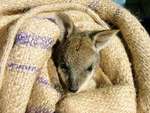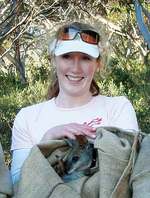Endangered wallaby comes home
 Science Science
A decision made 140 years ago has set PhD student Leah Kemp on a mission to help save one of South Australia's most endangered animals. For the past three years Leah has worked in collaboration with the SA Department for Environment & Heritage and Monarto and Adelaide Zoos on a project to re-introduce the mainland South Australian Tammar Wallaby (Macropus eugenii eugenii). The 27-year-old Environmental Biology student is in the final stages of a research project to assess the habitat use, movements, social groupings and diet of the first population of Tammar Wallabies repatriated to mainland South Australia from New Zealand. Tammar Wallabies became extinct on mainland South Australia in the 1920s due to loss of habitat and fox predation. Prior to their disappearance, former SA Governor (1841-1845) Sir George Grey was so taken with the Tammar Wallaby that he shipped some to Kawau Island near Auckland when he was appointed Governor of New Zealand in 1862. Ironically, the Tammar Wallabies taken to the predator-free Kawau Island some 140 years ago have thrived and are now declared a pest. Had it not been for Sir Grey's actions, the mainland sub-species would have been lost forever. In late 2003 the Federal and State Governments developed a cooperative program to reintroduce the Tammar Wallaby to South Australia. Eighty-five wallabies were repatriated from New Zealand and held in quarantine in Monarto Zoological Gardens pending an assessment of their health. A captive breeding program there has helped boost the numbers considerably. Leah's involvement with the project started in July 2003. Fourteen months later, 10 Tammar Wallabies were released into Innes National Park on the Yorke Peninsula. Since then, two more groups have been released into the park - 36 wallabies in June 2005 and another 36 in October 2006. With the help of her supervisors - Dr Sue Carthew, Acting Head of the School of Earth and Environmental Sciences, and Dr Greg Johnston, senior research scientist from the Adelaide Zoo - Leah has taken on the task of radio tracking the wallabies. Teams of people from Conservation Volunteers Australia have also helped out with Leah's project, which involves tracking the wallabies' movements all night, for up to a month at a time, and learning about their habitat use, home range, and foraging and social habits. Despite foxes depleting their numbers, some have thrived and developed strong survival skills for their new environment. "We even have some third generation Tammar Wallabies who are healthy and adjusting well," Leah said. The reintroduction of the Tammars to Innes National Park is the first stage of an experimental project to reintroduce the species to other suitable mainland sites. Leah expects to complete her PhD in mid 2007. Story by Candy Gibson
|






